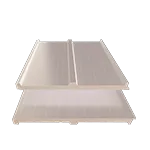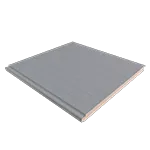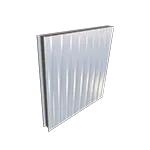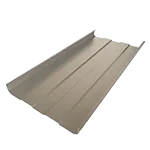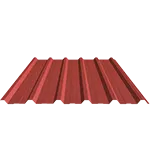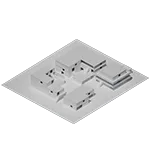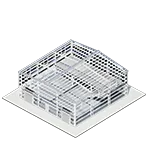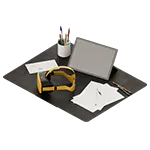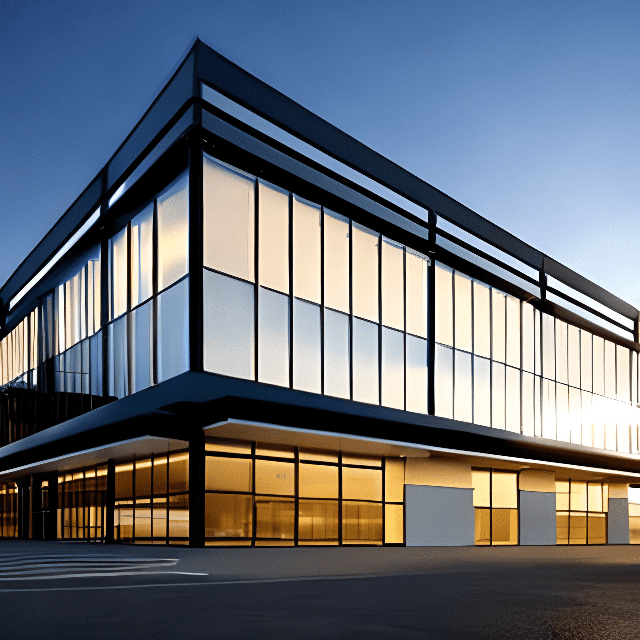Constructing a Memorable Building Facade
Facades are part of the building’s identity. They are the first expression and image that people perceive and condition the way people think about the use of the building. They represent the personality of the property and are its form of presentation to the environment.
In this article, we will review five aspects that are taken into account when designing the facade of buildings. The subject is approached without any rigorous technical character, but rather is the result of personal experience over the years, and a collection of assessments of architects and designers.
With this post, we seek to highlight the importance of the facade in an architectural project, the considerations about the environment, the strength we want to transmit with the forms and contrasts of the project, as well as an adequate selection of materials.
1. The image you want to display
During the 1950s and 1960s there was a debate among the most influential architects of the time as to whether the facade should be a reflection of what was going on inside the building.
This concept is the basis that develops a current contrary to what was being done in previous years, when the facade was an expression of opulence or power. Each of them was developed with different nuances, depending on the continent.
This search for functionalism had as a premise that everything that was built should respond to a function in itself. That is to say, the facade should reflect the functions of the interior. If it was a library, for example, its exterior aesthetics should be easily recognized as a library; if it was a factory, its facade should indicate that it was, in fact, a factory.
In the 80s and 90s this trend undergoes a turn because of technological advances in building systems and steel as well as glass take center stage. Some say it is a dark period of scarce creativity, others call it a necessary illness for the development of architecture at the end of the 21st century: “International architecture”.
We see examples of buildings with steel structures covered entirely in glass regardless of their use. From offices, shopping malls, institutional buildings, and, in some cases, even factories. It seemed that everything that was covered with glass was good.
The origin of this was in Anglo-Saxon and Nordic countries, where large windows took advantage of sunlight capture and generated open spaces connected to the surrounding environment. Although it was a valid solution for some environments, the growth without criteria, in the pursuit of modernity, led us to see this type of buildings in areas very close to the tropics.
The excessive use of air conditioners to counteract the greenhouse effect caused by this type of facade, made us rethink if the idea of modernity made all this valid.
In countries such as Mexico, the Caribbean, Central America, and Colombia, among others, a new wave of architects more conscious of the search for efficiency and optimization of resources, made them take a step back and rethink the use of this “international language” simply because it was trendy.
This is why, since the 2000s and beyond, new architectural movements have been looking for buildings that not only fulfill a function of identity but also provide appropriate solutions for efficiency and energy savings. The new image is: “I am green and responsible”. But more importantly, this must be true.
2. Environment
Eco sells. And it should not be only for the positive image it provides. The importance of knowing the conditions of the environment in which the building is located should be part of the variables and constraints to be resolved by the architect.
Solar incidence, prevailing winds, rain, snow, etc. Based on these conditions, the “skin that covers the building” must be the one that best adapts to these elements.
That is why in areas of Italian Tuscany we find facades of stone and clay stucco of the region, which not only gives us those colors that come to mind when we see movies of those latitudes but are materials that protect from extreme heat in summer and prevent heat loss in the cold nights of winter.
The same happens with the facades of some villages in the north of Spain and France, where we find picturesque the use of clay tiles covering their facades. This responds to a system of “waterproofing” of its walls to prevent the entry of moisture into the interior of the house in very rainy seasons.
Another example is the residential buildings in Lima, the capital of Peru, where their roofs are built without a slope, i.e., completely flat. The reason is that rainfall is practically non-existent, therefore, the roof does not need any pitch. If we could see these buildings from above, we would realize that most of them are used as open-air warehouses.
What is sought now is that the facade responds and dialogues with the unique and characteristic environment of the place where the building is built. In relation to this, the ability to function as a barrier to energy loss or transmission between the interior/exterior or vice versa makes the insulating panel an ideal option to be installed on facades.
3. The Shapes
Volume, walls, sunbreaks… Shapes nowadays tend to respond to users and we return to functionalism, the expression of the building’s function. Green facades, and blind walls in areas of high solar incidence for tropical climates.
Openings and overhangs help to direct air and wind flows towards the interior of the buildings, achieving air circulation for ventilation without the need for mechanical means in warm climate zones.
Angular or curved shapes contribute to improving the wind performance of high-rise buildings. In the skyscraper race, the wind tunnel is one more tool to find the external shapes of buildings that perform best in windy conditions.
The exterior shapes also help us to orient ourselves because they allow us to perceive where the access points are. They highlight or delimit the look toward pedestrian circulation points. The forms become part of the language that allows us to understand the function of the building.
Today, advances in the manufacture of materials such as, for example, insulated panels, provide us with a variety of possibilities to install as facades. From variations of textures and colors to the game of installation with variations of surfaces and geometric figures, making it a versatile product.
4. The Contrasts
Our brain is interested in what generates something unexpected, different, something that contrasts or stands out from the rest that surrounds it.
In architecture, the theory of “fleeing from the false historic” is often used in new buildings that are to be located on historic sites. By this, we mean that, if the building is current, it does not have to imitate exactly the adjacent old buildings. This is to avoid falling into duplicity with ease.
That is why one of the great masters of Mexican architecture, Teodoro González de León (1926-2016), together with his partner Abraham Zabludovsky developed a language of contrasts in the facade of their buildings in a subtle and even transitional way, but at the same time impregnated with identity.
On the opposite side, and always using Mexican architecture as an example, we find Luis Barragán (1902-1988), where the expression of contrast using color, and reinterpreting vernacular concepts, develops a new language that will impregnate and influence not only his work but also a series of architects of future generations.
We also have the example of Anglo-Saxons such as Eric Owen Moss (1943-), with remarkable works that seek to stand out through the language of contrast of their surroundings. What began as an experiment in urban renewal in Culver City, Los Angeles, is an example of how architecture can contribute to the recovery of urban spaces. Erick transformed through disruptive buildings with their immediate surroundings. With impossible facades and generating a new reading of the area.
5. Materials
We have discussed the example of the widespread use of glass. Years ago, during the XXVIII and XXIX century, the French influence of facades covered with metal sheets, in some cases of copper or zinc. Their use allowed cities in Central America, thousands of miles away from their origin, to have the opportunity to construct buildings resistant to the rains, which deteriorated the traditional mud walls.
With the beginning of the globalizing movements of that time, facades made of more resistant materials solved problems of humidity, seismic movements, and severe weather, different from their places of origin.
In some current urban centers, such as San Salvador, El Salvador, it is possible to find houses or institutional buildings from 150 years ago that are still standing and are covered with this facade material, innovative for the time.
It would be nearly impossible to list every single material available today for building façade fabrication. And technology and advances in design, modeling, and fabrication are pushing the boundaries of innovative solutions every day.
What I can mention is that there is a race for innovation in public, office, and recreational buildings. In housing solutions, little risk is taken and the most common solutions are left, such as: cement-based coatings, exposed brick, or the latest generation of stuccoes. And in some cases ventilated facades, which would be enough for a whole blog post.
In the industrial sector, where efficiency, simplification of shapes, and functionality are the priority, we can find applications in insulated panels. Thanks to its ease of installation, cost reduction, and good performance in reducing temperature variation from inside to outside, this is nowadays one of the most common materials for construction.
The insulated panel is a material that allows building users to obtain advantages not only of thermal type but also of acoustic type. Thanks to its core made of polyurethane foam (PUR), polyisocyanurate (PIR), or in some cases rock wool, the insulated panel works as a barrier against thermal losses inside/outside the building, but also as an excellent acoustic insulator.
Revolutionizing the building facade with insulated panels
These five aspects that we have reviewed in this blog give us an overview of the importance of the façade in conveying a building’s image and how architectural trends over the years have always generated a debate on function and shape.
How this dialectic is evolving and incorporating new concepts that enrich the debate at other levels: it is not only about being or not being a reflection of something but also about improving aspects of comfort, energy efficiency, reuse of materials, etc. All this is a greater benefit to the users of these spaces.
We have talked about 5 aspects that are the most common, but there are many more to comment on and discuss. A new element emerges from all this: the research of new materials that reflect the response to the search for new trends in efficiency, cost reduction, and shorter completion times.
The insulated panel is providing alternative solutions to traditional systems, and every day more and more space is opening within the non-conventional solutions, but that manage to collect many of the parameters of efficiency, cost, time, and comfort that are required. More options for housing and commercial proposals, more colors and better performance in adverse environmental conditions, and higher quality products adapted to every need.
The insulating panel has become one of the most versatile building systems today. A solution that architects and project developers can take advantage of.
